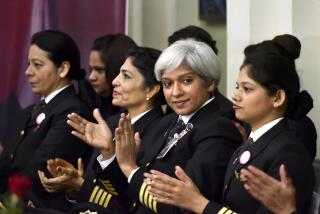Few Women in Top Ranks of Banking : Work Force Mostly Female, but Time Has Been on Side of Men
- Share via
In 1982, Elaine R. Bond was one of the subjects of a Fortune magazine article about the rising importance of women executives in banking. She was the highest-ranking woman at Chase Manhattan Bank in New York, a senior vice president and a member of the powerful policy committee.
But she had higher ambitions, telling the Fortune reporter, “I doubt I will be happy just being a senior vice president.”
Six years later, Bond, 52, is still a senior vice president at Chase, and no woman ranks higher, although there now are six women at her level. She said her job presents so many challenges that she has not worried about advancing to executive vice president or higher.
But Bond, along with many of her counterparts, wonders just how long it will take for women to break what some refer to as the “glass ceiling,” an invisible barrier that many women believe has kept them out of the executive hierarchy at the nation’s biggest banks.
“If you look at the statistics, you ask: ‘How come? Is there something at work other than merit?’ ” Bond said. “I’m optimistic, and I still see upward movement for women. The question is, when?”
U.S. banks have hired lots of women during the past two decades--two out of every three employees in the industry are female. And they can be found doing almost every job, including some management spots once regarded as the province of men.
But women are almost entirely missing from the senior management level at the nation’s biggest banks.
No CEOs, Vice Chairmen
An informal survey by The Times of the country’s 10 largest banking companies found only three women with titles of executive vice president or its equivalent among more than 200 senior executives. All three were in California--two at First Interstate in Los Angeles and one at Wells Fargo in San Francisco.
There are no women chief executives or vice chairmen at any of the 10 companies. And while all of them except San Francisco’s Bank of America had a woman on the board, only Chemical Bank in New York had two.
The trend is similar in other industries. There are only three female chief executives leading Fortune 500 companies. But the large proportion of women in the banking work force has raised questions in some quarters about whether the industry should not be leading the pack, rather than following the pattern.
“It is still very difficult for women to rise to the top,” said Myra Strober, a professor of education at Stanford University who has done research on women in the workplace. “Many men still don’t see women as the appropriate people to be in charge.”
Strides have been made--nearly half the officials and managers at big banks today are women, compared to one-fourth in 1975, according to the American Bankers Assn. The number of women at the senior vice president level, the rung right below senior management, has grown, and so has the responsibility granted them.
Nearly 60% of the branch managers at Los Angeles-based Security Pacific National Bank, the nation’s seventh-largest bank, are women. Almost half the branch managers at First Interstate are women. The senior vice president in charge of 160 B of A branches in Southern California is a woman.
Citicorp, the nation’s largest banking company, has no women at the level of executive vice president or above. However, two women with lesser titles are among the corporation’s 31 senior managers.
But it is still just a handful. Among the 117 senior vice presidents at Bank of America, eight are women. At Security Pacific, 10 of 87 senior vice presidents are women. At Wells Fargo, it is nine of 61. At Manufacturers Hanover in New York, it is eight of 106. And at Chase Manhattan, it is six of 74.
Last September, Citicorp brought its 600 top managers from around the world to a conference at the Century Plaza Hotel in Los Angeles. As Citicorp Chairman John S. Reed looked out over the audience, he remarked on the small number of women, about 6% of the total.
“This is not good enough,” Reed told the audience, “but it’s a start.”
Reed later sent the women pins bearing the figure “6%.”
Nominated Under Initials
Actually, the start at Citicorp came almost 20 years ago, and it was a bit halting. Walter B. Wriston was president of Citibank, the parent firm’s principal subsidiary. When he proposed that the board elect its first woman vice president, he was told the idea was unthinkable.
Wriston withdrew the nomination, waited a few months and then put her name in again, using only her initials. She was approved.
Those barriers have crumbled, and women executives interviewed for this article said they believe, by and large, that they have a fair shot at the top spots. Their explanation for why women still do not occupy those posh corner suites on the top floor was almost uniform--time.
The basic argument is that women who are committed to careers have not been around long enough to gain the experience necessary for the top spots. It takes an average of 35 years after college to become a CEO, which means that women would have had to get on the career ladder by about 1953.
Few women were in business school at that time. Most business schools began admitting increasing numbers of women in the early 1970s, and women now comprise a quarter or more of the enrollment in MBA programs at such prestigious schools as Stanford and Harvard. At Stanford, for instance, women comprise nearly one-third of current enrollment, compared to less than 2% in 1972. At Harvard, women make up 27% of the MBA students, compared to 4% in 1972.
Further, most banks did not allow women into management-training programs until about 15 years ago. Also, many women pursuing their careers through the 1960s and 1970s were relegated to the “velvet coffins” of personnel and corporate communications departments, excluding them from the line positions that provide the bulk of the top executives.
“It has taken a period of time for women to get the experience to be at the top,” said Linnet F. Deily, executive vice president at First Interstate Bank of California and one of the three women at that level within the 10 biggest bank companies. “It is appropriate to expect 20 to 30 years experience, and not many women were on the ladder that long ago.”
Some women, however, are suspicious of the argument that all it takes is time for women to reach the very top spots.
“I asked the president of Crocker National Bank when there would be women in top management,” one female California banker recalled. “He told me, ‘Now that we’ve got women in the pipeline, it won’t be much longer.’ That was eight years ago.”
Crocker had no women in senior management when it was absorbed in 1986 by Wells Fargo in San Francisco. However, Wells recently joined First Interstate on the short list of two bank holding companies among the top 10 with women at the executive vice president level.
Despite their scarcity at the top, most women bankers said there are no roadblocks to their advancement.
“I think that I have been treated like everyone else,” said Lisa J. Prescott, the senior vice president in charge of 160 Bank of America branches in Southern California. “To get from one level to another requires the same effort no matter what sex you are.”
Yet Prescott, who is married and has a 7-year-old son, acknowledged that women executives sometimes grapple with a different list of priorities than men do.
Total Commitment
“When I’ve had to juggle and determine priorities, I’ve generally chosen work first,” she said. “You have to be willing to do what anybody else is willing to do.”
Susan B. Taha, who became one of the first two female senior vice presidents at Security Pacific in 1983, said the unwillingness or inability of some women executives to devote every waking moment to the corporation may hold them back.
“In all honesty, I think women have come a long way,” said Taha, director of corporate communications. “But the top executives here, they live their jobs 28 hours a day. That is one of their problems with us.”
Strober, the Stanford professor, agreed that many women do not want to make the total commitment required from the very top executives at any corporation.
“There are also a lot of men who don’t want to make those kinds of commitments,” she said. “But the way corporate America is structured today, it is likely that only people who make those kinds of commitments are likely to get ahead. And the pool of women who want to work 30-hour days is smaller than the pool of men willing to do it.”
More to Read
Inside the business of entertainment
The Wide Shot brings you news, analysis and insights on everything from streaming wars to production — and what it all means for the future.
You may occasionally receive promotional content from the Los Angeles Times.










